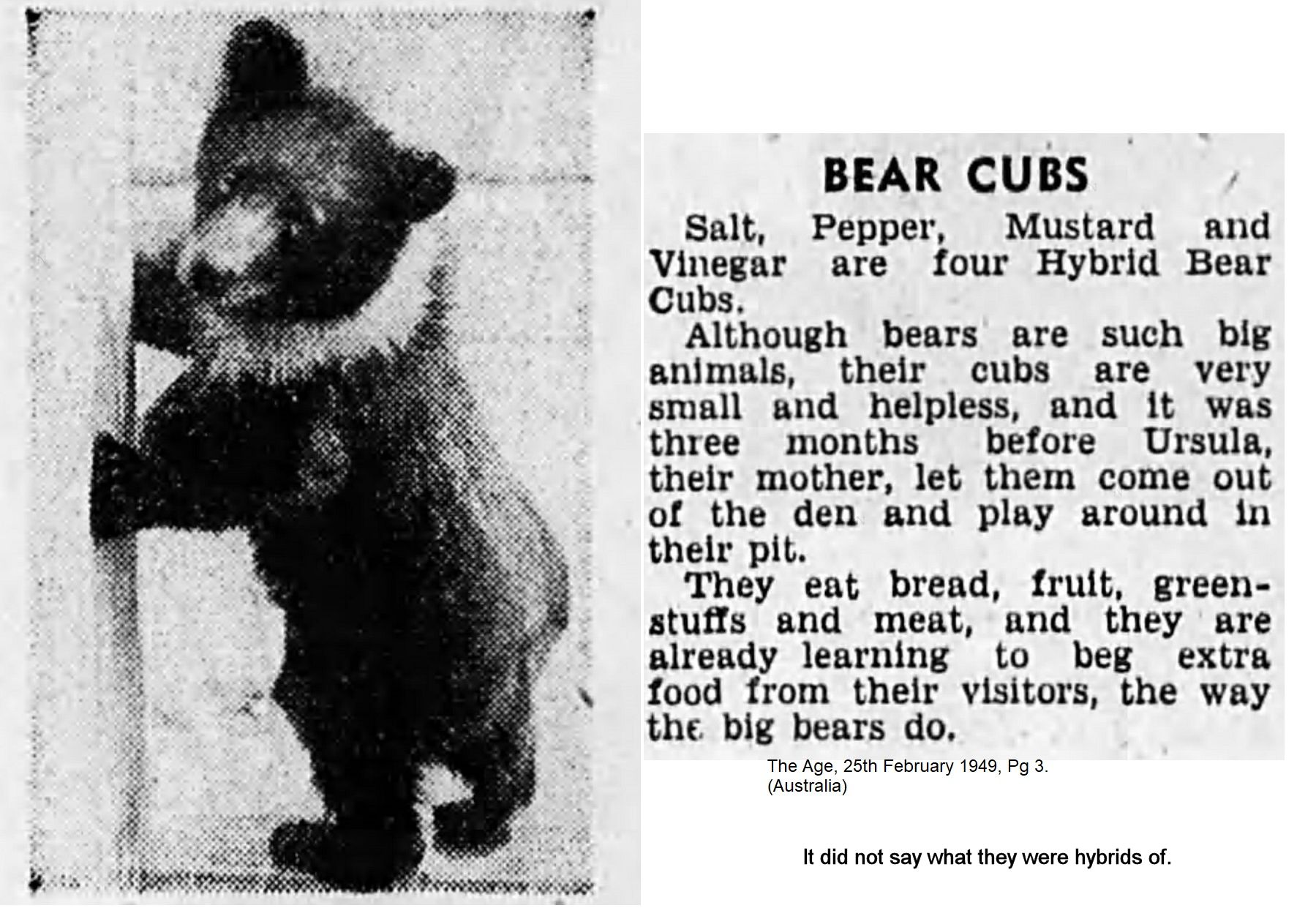
|
HYBRID BEARS |
Polar Bear hybrids are detailed on a separate page. All the Ursinae species (all bears except the giant panda and the spectacled bear) appear able to crossbreed and will do so if placed together; all have 72 chromosomes except for Spectacled bears (53 chromosomes) and Pandas (42 chromosomes).

BROWN BEAR X BLACK BEAR HYBRIDS
In "The Variation Of Animals And Plants Under Domestication" Charles Darwin noted: "In the nine-year Report it is stated that the bears had been seen in the Zoological Gardens to couple freely, but previously to 1848 had most rarely conceived. In the Reports published since this date three species have produced young (hybrids in one case) [...]" The black bear and the European brown bear were successfully crossed in the London Zoological Gardens in 1859, but the three cubs did not reach maturity. They seem to have been born at a very small size. Here is a report on the cubs at the age of 5 - 6 weeks.
NOTES ON SOME YOUNG HYBRID BEARS BRED IN THE GARDENS OF THE ZOOLOGICAL SOCIETY. By A. D. Bartlett, Proceedings of the Zoological Society, 1860:- In the Bear-pit in the Gardens a male Black Bear of America (Ursus americanus) has been kept for a long time with a female of the European Brown Bear (Ursus arctos) . In the month of May these bears were seen to copulate, and on the 31st of last December the female produced three young ones; which, when born, were naked and blind, and about the size of a full-grown rat. The mother was seen to carry one of these young ones in her mouth a day or two after they were born, and, as it disappeared, it is supposed that she devoured it. Probably it was not healthy. The other two remained and continued to grow, and at the age of five weeks were as large as a common rabbit. Their eyes began to open by this time; they were covered with a short thick fur and were nearly black. On examining these young bears, it was found they were male and female, and the number and situation of the teats appears somewhat remarkable. They have six teats, four of them placed in front between the fore legs, and two of them in the lower part of the abdomen. Another singular fact is, that the female during the time she was suckling these young ones fed most sparingly, and rarely took any drink. From the before-mentioned observations we may infer that the period of gestation of the Bears is about seven months.
True Republican, 20th March 1920, page 6: " BEAR CUBS PROBABLY UNIQUE. New Species the Result of Mating Canadian Black and Russian Brown in London Zoo. A marriage was arranged in London some time ago between Teddy, the black bear from Canada, and Daisy, the brown bear from Russia. The result is the first hybrid black-brown bear cubs ever born in the zoo - they may even be unique, for nature left alone produces no hybrids. They are a rich mahogany compromise between their parents colorings, and are doing splendidly.
Hybrids between the brown bear and the grizzly-bear (considered by some to be a form of brown bear rather than a species) have been produced in Cologne.
American Black Bear (Ursus americanus) x Brown bear (U. arctos). Hybrids of both sexes are recorded and a hybrid was successfully backcrossed to a Brown Bear. A record size Black bear shot in Alaska was found to be a natural hybrid.
"A bear shot in the Autumn of 1986 in Michigan [it was actually shot in Alaska, not Michigan] was thought by some to be a black bear/grizzly hybrid, due to its unusual size and its proportionately large brain case and skull. DNA testing was unable to determine whether it was a large American black bear or a grizzly bear." [It may have been a second generation hybrid that was a75%-25% mix.]
BROWN BEAR HYBRIDS (SUBSPECIES HYBRIDS)
A Peculiar Bear From Alaska, by Wilfred H. Osgood, Assistant Curator of Mammalogy and Ornithology. Field Museum of Natural History. Publication 138. Zoological Series. Vol. X, No. I. Chicago, U. S. A., November, 1909.
[The two "species mentioned here are now reduced to a subspecies or a colour variant of the black bear.]
In view of the scanty knowledge of the small Alaska bear known as the glacier bear, it seems important to publish a figure and a description of a peculiar specimen (No. 13768) now on exhibition in Field Museum. This skin (there is no skull) was purchased from the fur dealers C. F. Periolat and Son by Mr. V. Shaw Kennedy and by him presented to the Museum. Later it was mounted by Julius Friesser, one of the Museum's taxidermists, and placed on exhibition. The skin is practically complete although some slight restoration of parts was necessary about the nose and one of the feet. It was received by the fur dealers with a consignment from Alaska, and according to report was obtained in the region of Mount St. Elias.
Its principal peculiarity is in the fact that it is very much darker than the majority of specimens heretofore regarded as representing typical Ursus emmonsi. Gray hairs are scattered throughout the pelage of the entire animal, but the predominating effect is black. The black is intense and nearly unmixed with gray on the lower cheeks and throat and thence down the middle of the breast. The nape and sides of the neck also are nearly pure glossy black. The outer sides of the forelegs and the front of the hind legs and the feet are chiefly black. On the feet, forelegs, and breast the hairs are mostly black to the roots but elsewhere in the areas which appear black on the surface, the hairs are grayish at the base. The parts of rather more gray than black are the lower shoulders, the sides, and the hips, but practically all the hairs are broadly tipped with black, the total amount being much greater than in ordinary Ursus emmonsi. A black line from the nape to the tail is fairly distinct and the tail itself is mostly pure black. The top of the rostrum is rich ferruginous slightly mixed with creamy, while sparsely scattered ferruginous or creamy hairs extend backward to the occipital region and nearly to the base of the ears, becoming fewer and largely replaced by white hairs posteriorly. The extreme tip of the nose and parts of the lips were missing when the skin was received and are shown restored in the mounted specimen.
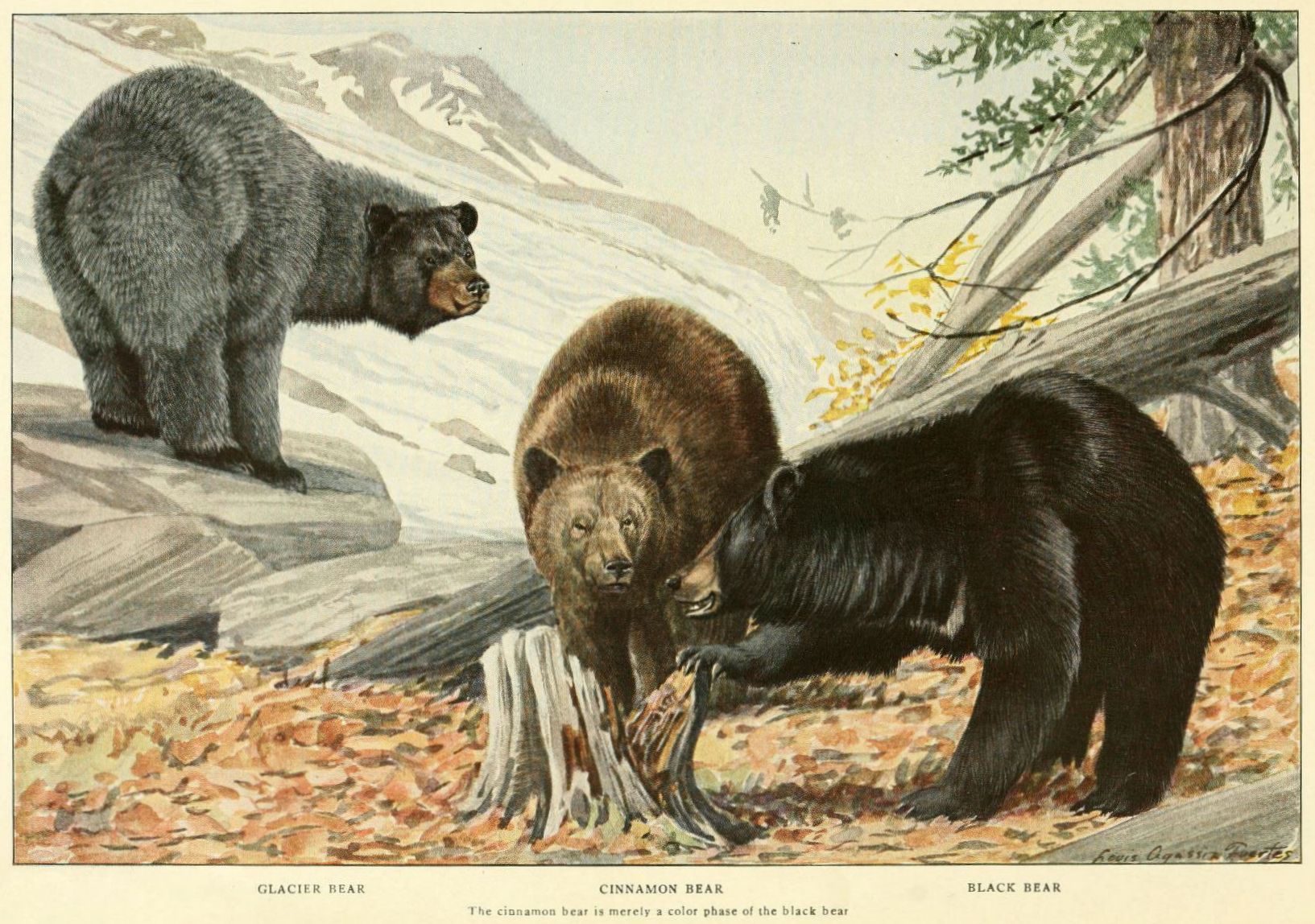
It is evident, therefore, that this peculiar Lear is practically intermediate in color between the glacier bear (emmonsi) and the pure black bear (americanus) . By some, no doubt, it would be regarded as a hybrid and this it may very well be, but with the present limited knowledge of Ursus emmonsi as a species, any conclusion in regard to it is somewhat hypothetical. In casting about for an explanation of the peculiarity of this specimen, other than that of hybridity, one finds some probability in the idea that Ursus emmonsi may not be a species nor even a subspecies but only a color phase of Ursus americanus. It should be emphasized perhaps that such an idea is distinctly hypothetical and of value only as a possible alternative to be kept in mind in judging such facts as may be disclosed from time to time in the future.
Many circumstances in addition to our specimen lend probability to the view that the glacier bear may be a color phase. Since its discovery some fifteen years ago, scattering skins more or less similar to those seen by the original describer have found their way to various American museums and private collectors. The total number is very small, perhaps not exceeding fifteen,* in spite of the recent activity of travelers and collectors on the coast of Alaska. Of this small number, the majority are imperfect and nearly all are unaccompanied by skulls or with imperfect ones only. The number of authentic observations regarding the habits and distribution of this interesting bear is still smaller and our entire knowledge of it, therefore, is exceedingly incomplete. All the specimens thus far received are from a small part of the coast of Alaska, extending approximately from Lynn Canal to Cape St. Elias. The fact that this is a region of great glaciers caused the animal to be called the glacier bear and from this the idea soon prevailed that it lived exclusively in and about the glaciers and had otherwise remarkable habits. The same region is inhabited also by black and brown bears, both of which, especially the former, are frequently found on or near the glaciers. In fact, from such evidence as can be obtained from the inhabitants of the region, both white and Indian, there is not the slightest foundation for the belief that the habits of the so-called glacier bear differ in any way from those of the ordinary black bear of the coast of Alaska.
* My own observation includes only eight, all in public museums, but several are known to be in private hands and doubtless a few others have been preserved.
So far as can be judged by material now available, there is no proof that the glacier bear differs from the black in cranial characters, such fragmentary skulls as have been received being identical in every respect with those of black bears from the same region. That it has been thought to be smaller than the black bear is explainable by the probability that a majority of the skins thus far received are those of females or young. Therefore, the only peculiarity of Ursus emmonsi is its gray color, which it now appears is subject to marked variation. As a specific character, this peculiarity might sooner have been questioned if the animal were not a large game animal of much popular interest and one of which it is impossible to obtain large series of specimens from single localities. Probably five hundred black bears are killed on the coast of Alaska to one of the gray color representing Ursus emmonsi.
If occasional specimens showing divergence in color are found among large series of a given species of small mammal, it is not unusual to regard them merely as examples of dichromatism. Especially is this the case if the species be one in which dichromatism is already known to occur. It is very significant in this connection that the cinnamon phase so well known in other parts of the black bear's range is unknown on the coast of Alaska. That a gray phase may represent it there certainly is not impossible. Another interesting factor in the case is the white bear of the coast of British Columbia, called Ursus kermodei, which some regard as an albinotic phase of Ursus americanus. Evidently there is an unusual instability in the color of the small bears of the American northwest coast. Doubtless extremely interesting results would be obtained if some of our zoological parks should be so fortunate as to obtain living examples of these bears and to successfully breed them in captivity.
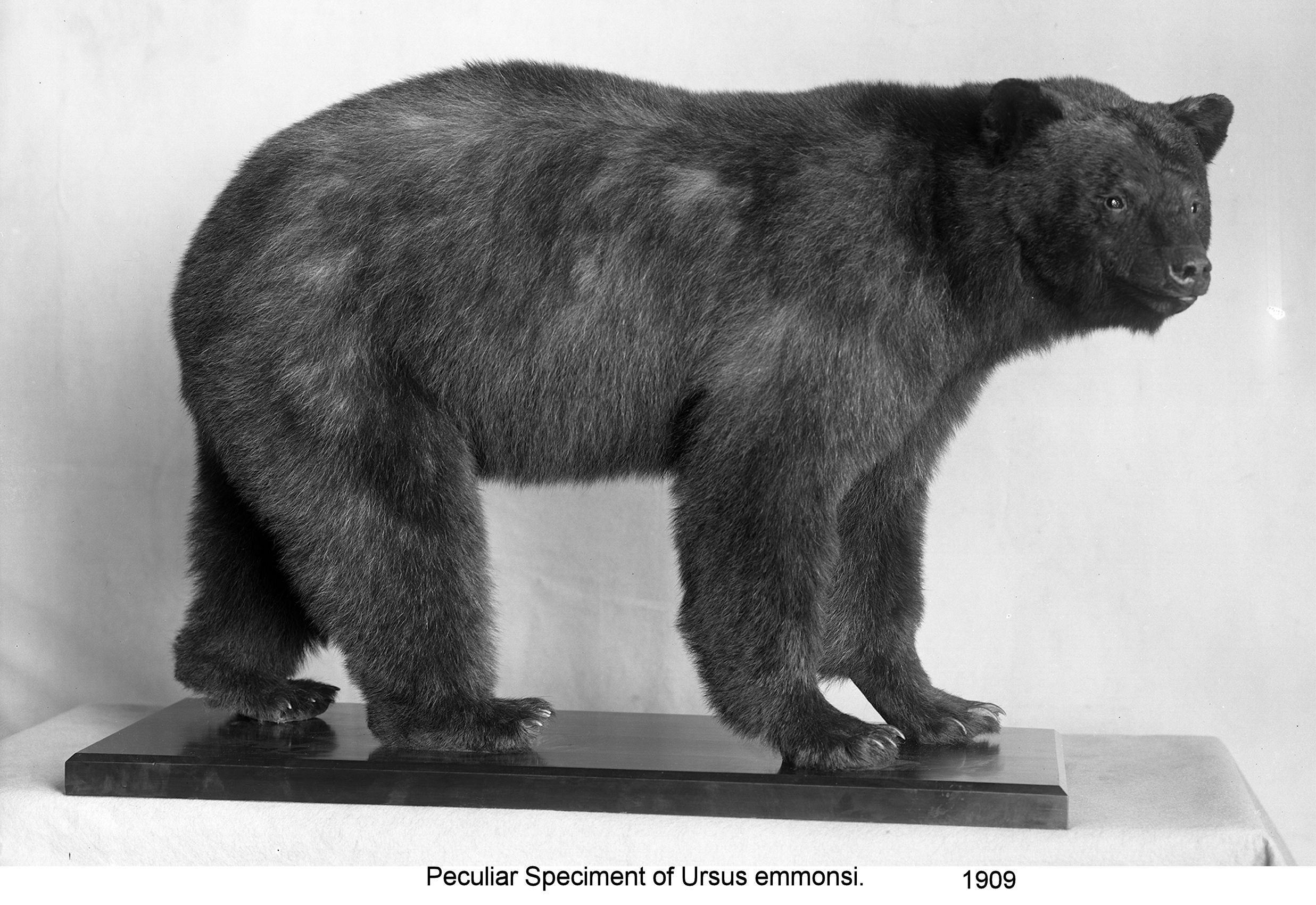
In 1989-90 Jim Clubb had a circus act with 3 polar bears, 3 Asian Black bears and 2 Kodiak-Grizzly hybrids (one of which is pictured). The grizzly bear (Ursus arctos horribilis) and the Kodiak bear (Ursus acrtos middendorffi) are both subspecies of brown bear, the Kodiak bear living in coastal environments and the grizzly living inland.
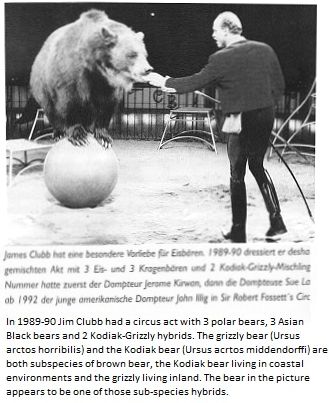
According to the Alabama Journal, 8th January 1969 (pg 4) "The second oldest inhabitant [of the National Zoological Park, Washington, D.C.] is believed to be a hybrid bear named Biggy, born at the zoo in 1936. As this is not the name of any of the polar/Alaskan brown bear hybrids born that year, I assume Biggy was one of their Kodiak/grizzly hybrids.
BLACK BEAR HYBRIDS
A hybrid between a Himalayan black bear and a North American black bear was supposedly born in the wild in the wild in Florida, after a Himalayan black bear escaped from a circus. According to Jack Hanna, author of "Monkeys on the Interstate" who helped wildlife officials capture the bear when it wandered into a residential area, "The bear was thought to be the offspring of a rare Himalayan sun bear [note: an error - Sun Bears are Malaysian] that had escaped from a circus several years back. He'd probably come down from the Ocala National Forest forty or fifty miles to the north, probably just walked right along the freeway. We released him back into the forest three weeks later. It was all tremendous publicity for the zoo.".
BLACK BEAR X SPECTACLED BEAR
Between 1963 and 1991, the "Parque Zoologico Las Delicias“ exhibited a male Spectacled bear (Tremarctos ornatus) originating from a forest in the vicinity of Sanare, Lara State, Western Venezuela. Since 1964, it shared its enclosure with a female Asiatic black bear (Ursus thibetanus/Selenarctos thibetanus) originating from the Miami Zoo, U.S.A. The pair mated frequently resulting in several pregnancies, but all of the cubs died (due to inadequate housing) except for a male born on September 11, 1975. The diploid chromosome number of the Spectacle Bear is 52, compared to 74 in the Asiatic Black Bear.
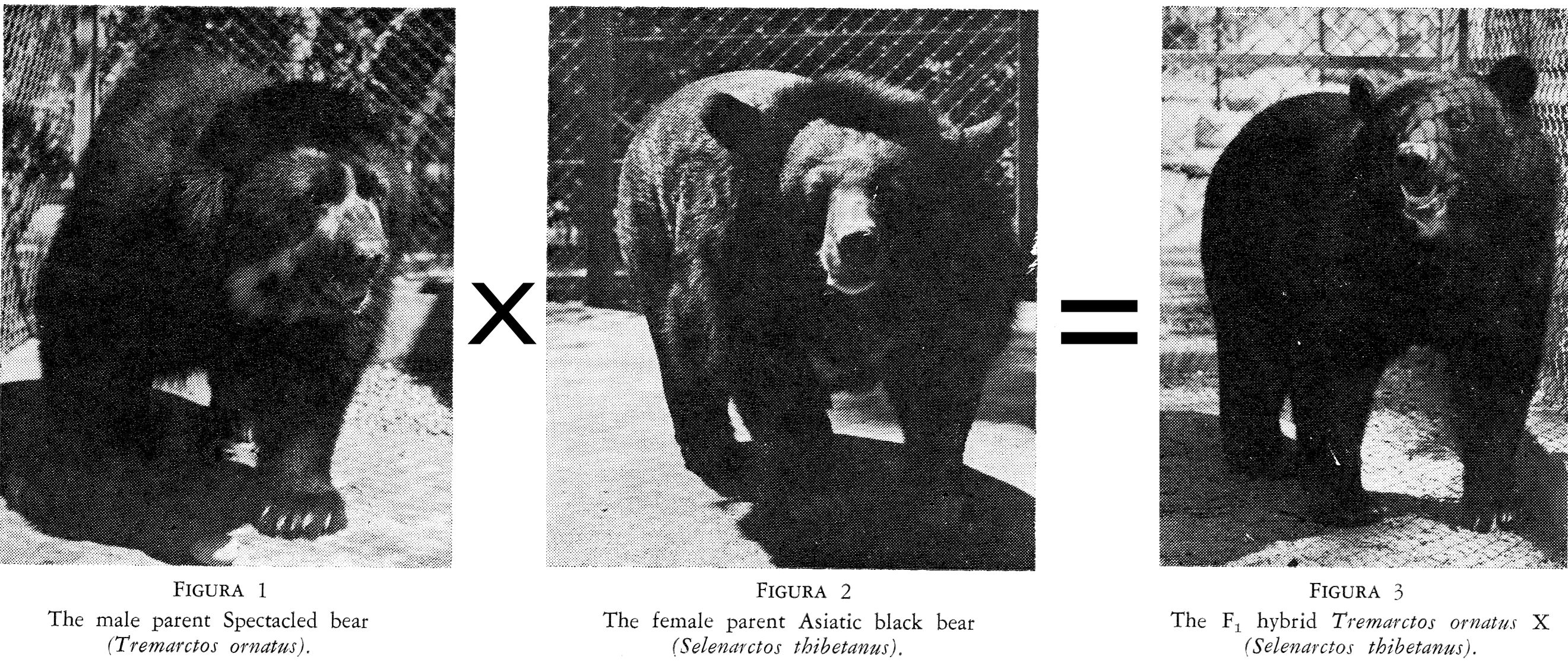
At 6 and-a-half years old, this hybrid was healthy, vigorous and well grown. The Spectacled bear sire has characteristic throat and chest markings and brownish muzzle, while the female has a crescent shaped white mark on the chest, white lower lip, rounded erect ears and conspicuous ruff around the back of the head. The hybrid bear is shiny black all over, except for the whitish lower lip and jaw, and a very faint white vertical stripe in the middle of the chest. The muzzle is blackish, as in the Asiatic black bear mother and somewhat longer and more tapered than that of the Spectacled bear. There is a small, but noticeable, ruff around the back of the head. The rounded ears are raised more than those of the Spectacled bear. In general, it resembles an American black bear. A previous hybrid male cub was born between October and November of 1974, but died as a young cub. Its skin and skull are preserved in the mammal collection of the "Estacion Biologica de Rancho Grande", Venezuela. It was black with a slight reddish brown tinge and a white spot on the lower jaw.
ASIATIC BLACK BEAR X BROWN BEAR
In 2010, an Asian black bear/brown bear hybrid, rescued from a bile farm, was housed at the Animals Asia Foundation's China Moon Bear Rescue.
SUN BEAR X ASIATIC BLACK BEAR
In 2008, Galbreath et al described an apparent wild hybrid of the Asiatic black bear or moon bear (Ursus thibetanus) and the smaller sun bear (U. malayanus). Their ranges overlap extensively in mainland south-eastern Asia, including Cambodia where this bear was found. They have co-existed in Southeast Asia since the middle Pleistocene. In 2005 an unusual looking male bear cub was found by Forestry Rangers near the O Koki River in Preah Vihear Province. By spring 2007, it was housed at the Phnom Tamao Zoological Gardens and Wildlife Rescue Centre, Takeo Province, Cambodia. This bear was mainly black and its body resembles the Asiatic black bear, including the pale chest marking. It had a slight mane, forming a crest either side of the neck, like the sun bear and some Asiatic black bears. Its head was intermediate between the two species. It had small ears and very large, stout canines like those of the sun bear. In brief, it resembled an Asiatic black bear with an unusually glossy coat and an unusual head.
Its mitochondrial DNA (which is inherited only from the mother) matched that of the Sun bear. Nuclear DNA was not analysed at that time (this was later found to be a mix of Sun Bear and Asiatic Black Bear.), but in conformation the bear more closely resembled the Asiatic black bear so it was housed with Asiatic black bears at Phnom Tamao. Despite the sun bear ears, canines and mitochondrial DNA. The researchers concluded that it was an interspecies hybrid (later determined to be male Asiatic Black Bear and female Sun Bear). There were no zoos or other potential sources of escaped hybrids in the remote region where it was found, therefore, it was concluded to be a wild-bred hybrid.
- Gary J. Galbreath, Matt Hunt, Tom Clements, and Lisette P. Waits. An apparent hybrid wild bear from Cambodia. Ursus 19(1):85-86 (2008)
SLOTH BEAR X MALAYAN SUN BEAR, SLOTH BEAR X ASIATIC BLACK BEAR
A sloth bear was hybridised with a Malayan sun bear at the Tama Zoo, Tokyo, and also with an Asiatic black bear (Selenarctos thibetanus) (Gray, 1972; Asakura, 1969; Scherren, 1907).
Sloth bear x Malayan sun bear hybrids were reported by Shigeharu Asakura (General Curator, Tama Zoological Park, Tokyo, Japan) in "A Note On A Bear Hybrid - Melursus ursinus x Helarctus malayanus - at tama Zoo, Tokyo) published in 1969. The zoo had kept a pair of Malayan sun bears (Helarctus malayanus) in the same enclosure as some Sloth bears (Melursus ursinus) since they were young. They were all on friendly terms with no aggression between the individuals of the 2 species. About 5 earlier, there had been occasional sexual behaviour between the Sloth bears, but they had not bred. The Malayan Sun bears had shown no signs of sexual behaviour at this time, except for occasional unsuccessful mounting behaviour by the male.
On 12/06/1966, keeper Yoshio Takura observed a male Sloth bear copulating with a female Malayan Sun bear. 95 days after the mating, on 14/09/1966, the female produced a single male cub. The hybrid came to resemble the Sloth bear father in terms of hair, body shape and colouration.
SLOTH BEAR X BROWN BEAR
Sloth Bear (Melursus ursinus) x Brown bear (U. arctos) a hybrid was born at New York Zoo in 1916, but was destroyed in 1918 because it was so savage that its keepers could not enter the dens at cleaning time.
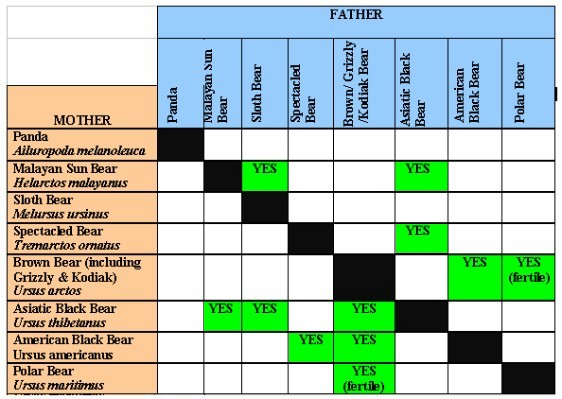
More information:
Asakura, S. 1969: A note on a bear hybrid, Melursus ursinus x Helarctos malayanus, at Tama Zoo, Tokyo. Int. Zoo Ybk. 9:88.
Gray, A.P. 1972: Mammalian Hybrids. A Check-list with Bibliography. 2nd edition.
Kowalska, Z. 1962. "Intergeneric crossbreed of the brown bear Ursus arctos L., and the polar bear Thalarctos maritimus (Phipps)." Przeglad Zoologiczny, 6:230, 1 pl. [Polish with English summary.]
Kowalska, Z. 1965. "Cross breeding between a female European brown bear and a male polar bear in Lodz Zoo." Przeglad Zoologiczny, 9:313-319. [Polish with English summary.]
Kowalska, Z. 1969. "A note on bear hybrids Thalarctos maritimus and Ursus arctos at Lodz zoo." International Zoo Yearbook, 9:89.
Martin, P.L. 1876. "Ursus arctos and Ursus maritimus. On bastards between these species born in Nill's menagerie at Stuttgart." Zoologische Garten, 1876:20-22. [Zoologische Garten, 1877:135-136. W. Stendell and E. von Martens, tom. cit., pp.401-402.]
Martin, P.L. 1882. "On a hybrid between a male Ursus maritimus and a female Ursus arctos." Pederson, A, 1957; "Der Eisb r", Neue Brehm B ch. No 201: 1-64
Wurster-Hill, D.H. and Bush, M. 1980: The interrelationship of chromosome banding patterns in the giant panda (Ailuropoda melanoleuca), hybrid bear (Ursus middendorfi x Thalarctos maritimus), and other carnivores. Cytogenet. Cell Genet. 27:147-154.
Scherren, H.: Some notes on hybrid bears. Proc. Zool. Soc. London 431-435, 1907.
Alexandra Preu , Udo Ganslo er, G nter Purschke and Ute Magiera. 2009: Bear-hybrids: behaviour and phenotype. Der Zoologische Garten Volume 78, Issue 4, 2009, Pages 204-220
Textual content is licensed under the GFDL.
|
BACK TO HYBRID & MUTANT BIG CATS INDEX |